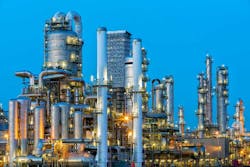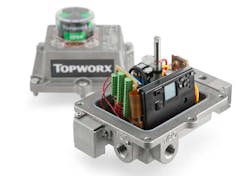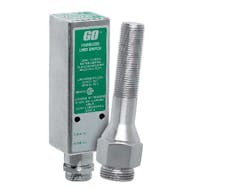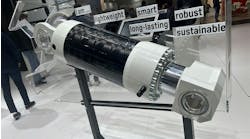At a Glance:
- For fluid power managers, maintaining visibility for key actuators and processes is critical.
- Digital transformation allows operators to record data that reflects the current state of their assets.
- Optimizing operational processes puts into motion an unending cycle of information. This cycle includes three stages: See, Decide and Act.
Because high volumes of oil, gas or chemicals are moved every day, fluid power managers at such refineries are challenged with maintaining the actuation of process valves that control fluids and gases that are at the center of a plant’s performance. Unmeasured parameters or unknown anomalies can compromise the valve package, resulting in catastrophic failure. If critical process valves and actuators fail, refineries suffer unplanned shutdowns that result in millions of dollars lost each day. To protect the area and maintain uptime, knowing the condition of assets, systems and equipment is critical.
Many plants don’t yet have ways to monitor and measure asset health. If they do, such measurements often are ineffective and potentially hazardous to workers. For some, service is time-based and performed in a fixed cycle or at a periodic interval. Others are reactive, running machines until components fail, then making repairs. Both have high operations and maintenance costs and a high frequency of unplanned downtime.
The third option is to use technology that enables operators to see the real-time health and condition of their assets remotely so they can make informed, proactive decisions that maintain the valve package and minimize unplanned downtime. Refineries use digital transformation to automate and optimize operational processes in order to keep processes running as long as possible and to keep personnel safe.
Benefits of Digital Transformation
To some, the term “digital transformation” may sound cryptic and complicated, but it really is about taking practical steps to make operations clearer, easier and more concrete. By definition, digital transformation is a process that a facility, system or piece of equipment undergoes that allows end-users to see real-time data, make decisions based on it and act based on those decisions. Digital transformation puts the right information in the hands of the right expert, no matter where they sit, which improves the speed and accuracy of decision-making and action.
Some facilities manually measure and record critical data such as valve cycling and position. This “scorecard-and-stopwatch” process means that people must climb ladders and take catwalks to get data that’s already outdated by the time it can be used for decision-making. There also are some measurements that can’t be taken, so even stale data can’t be accessed.
Digital transformation allows operators to easily record data that reflects the current state of their assets. The information can be reviewed from a handheld device or control room workstation. The digital transformation of a machine can be as simple as adding a sensor that captures data about its current performance and health. Through this process, real-time information is collected and converted into useful analytics and insights that can be used to automate a task, like moving from clipboards to digital record keeping or optimizing an area around safety, production, energy use or reliability.
In this way, digital transformation gives operators access to a previously hidden level of asset health and condition, affording them a deeper understanding of assets in their present state and the ability to compare them to the past, and even to predict the future. This empowers operators to make confident, informed decisions that significantly improve their operations, resulting in greater reliability, cost savings and safety.
Setting the See-Decide-Act Cycle in Motion
Automating and optimizing operational processes using technology puts into motion an unending cycle of information. This cycle includes three stages: See, Decide and Act. In process applications, different fluid control devices automate each stage.
See. This starts the cycle at the sensor. Sensors and switches collect vital data about process valves that allows operators to see measurable input—such as cycles, temperature, contact status and position—in real time. These sensors are linked to technology that enables connectivity, such as a discrete valve controller.
Decide. a discrete valve controller sends sensor data to a control device, such as a distributed control system (DCS) or safety instrumented system (SIS) DCS.
The DCS analyzes and visualizes the data, translating it into dashboards that operators can easily interpret and synthesize. By quickly and clearly understanding what data means for operations, operators gain the expertise that empowers them to make better and faster decisions with confidence.
Act. Mobility tools enable the appropriate personnel to access preset alerts, information and prescribed actions from multiple platforms. These critical actions spur personnel to repair an asset or replace a component and are a vital step that improves safety and reliability.
The collaboration of these layers provides valuable analytics and services that enable device life-cycle management, position feedback, transition dwell time and internal device temperature. This constant cycle of seeing, deciding and acting creates a technology loop that continuously improves expertise and efficiency.
Using Technology to Automate and Optimize Operational Processes
While sensing and feedback devices are available discretely, there are also integrated solutions available. Some discrete valve controllers combine sensing technology and a HART 7 module—as well as other components, such as a solenoid valve for piloting—in a single housing. This switchbox sits on top of the valve package.
While the position sensing switch monitors valve position, the HART module captures data from the sensor and sends it to the control system, which analyzes it and carries out appropriate actions in response to it. Analytics and diagnostics about valve condition, including position percentage, transition dwell time, last open/close stroke time, internal device temperature and cycle count, can be delivered to the appropriate personnel via handheld device or at a control room workstation.
As a critical part of the technology loop, integrated switchbox solutions help refineries solve several challenges. One big issue is maintaining uptime. Continuously monitoring performance lets operators improve the visibility of the valve package condition. The system sends alerts based on preset parameters to maintenance staff when necessary. This shifts plant maintenance from reactive to proactive maintenance.
Predictive and prescriptive maintenance analytics improve decisions around device and system replacement, reducing unplanned shutdowns while lowering scrap, repair and labor costs. When a single shutdown of a valve can cost $1.3 million a day just in lost output, and a plant may likely experience 27 days of unplanned shutdown a year, costs add up fast. Reducing unplanned downtime by 36% through proactive maintenance results in significant savings.
By automating and optimizing maintenance, as well as data collection and delivery, discrete valve controllers like this also enhance safety. Proactive maintenance and preset safety alerts and alarms reduce the frequency of maintenance rounds, while remote monitoring of valve package condition curtails the need for workers to be physically close to the asset. Fewer maintenance and troubleshooting trips decrease the frequency of possible injury and improved insights empower personnel to make better safety decisions.
When properly networked, discrete valve controllers with a HART 7 module can also rescue stranded data, which can offer additional insights and further improve uptime and safety. An estimated 85% of HART devices in operation experience stranded information due to accessibility issues or legacy control systems.
Capturing diagnostics and parameters using traditional cabling may be too expensive or, in offshore applications, too heavy. As part of the integrated switchbox solution, HART can be networked with gateways either wired or wirelessly via an adapter, and connected to stranded devices wirelessly or a cable/wireless hybrid solution. As a global standard to exchange digital information, HART undergoes revisions that enhance its capabilities and can absorb or umbrella the previous version, creating a long-term, future-proof investment.
Accelerating Digital Transformation with Connected Technologies
By automating and optimizing operational processes, the digital transformation of process valves and actuators helps refineries solve critical challenges they face. And facilities don’t have to face those challenges, or digital transformation, alone.
Whether they have a mature technology strategy or just starting on a digital transformation, plant managers can partner with an expert in helping hydrocarbon facilities navigate digital transformation. Such providers have a comprehensive offering, from valve to control system, from software to services, and can meet a plant at any stage in its journey.
Digital transformation doesn’t have to feel unknown, ambiguous or scary. It’s built upon a foundation of data, which facilities have in abundance. Refineries can reliably access and put to work their data pools using reliable technology backed by expert support. By automating and optimizing their operational processes, refineries can better understand the condition of their process valves reduce risk and reach new levels of uptime.
Jason Maderic is director of global marketing at TopWorx for Emerson. In his role, Maderic specializes in discrete valve controllers. He has been with Emerson for three years.
Amit Patel is marketing manager for digital transformation within the Fluid Control & Pneumatics business at Emerson. He focuses on driving the marketing direction and strategic vision for the Industrial Automation segment.




